The First World War lasted less than two months, when on September 22, 1914, the German submarine U-9 commanded by Capt. Otto Weddigen has accomplished an extraordinary feat. This inconspicuous unit with a crew of only 29 people torpedoed and sank 3 British cruisers within an hour. More than 1,400 sailors died on their decks. The Royal Navy, humiliated in the face of the U-boat threat, turned out to be completely defenseless.
At the outbreak of the Great War, the submarine fleet of Kaiser Germany consisted of only 29 units. A further 21 were at different stages of construction. Submarines were treated somewhat neglected at the time . The real threat was not taken seriously into account, and patrol and reconnaissance activities were rather reserved for them. The main weapons of the fleets were to continue to be powerful battleships and cruisers. However, the first months of the conflict painfully verified these views.
The wolf goes hunting
According to the order of the U-9, it was supposed to go to sea from the Helgoland base on September 16, 1914. The task of Capt. Weddigen was the reconnaissance of the movements of French and British ships and ships in the area of the Belgian Ostend. Bad luck came with the Germans at first. Due to a severe storm in the North Sea, departure from the port was postponed by three days. 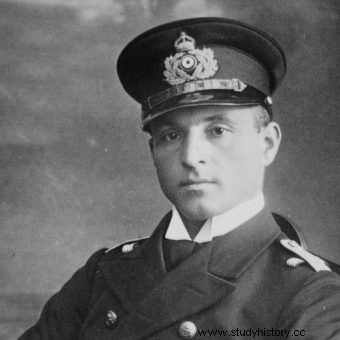
Two days later, near the Dutch island of Ameland, the compass broke and the crew had to navigate using only visual observation. The sea was still turbulent and, while sailing in such conditions, the U-boat ended up in the area of the entrance to the Dutch port of Scheveningen. There, Weddigen decided that the U-9 would wait out the stormy night lying on the bottom, which proved impossible due to the risk of damage to the hull. The Germans therefore faced a tough night on the ship tossed by the waves.
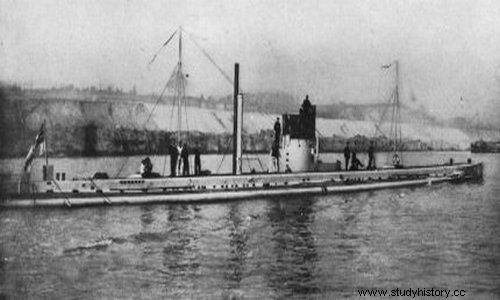
U-9 - Captain Otto Weddigen's ship ready for the next combat voyage. Maybe this time it will be possible to send an impressive ship to the bottom, or maybe a warship?
In the morning, around At 6.00 a.m., the watchman at the kiosk reported that he had noticed the tops of the masts on the horizon. In this situation, Weddigen ordered an emergency dive and directed the U-9 to the intersection of the course of the spotted vessel in order to identify it visually. Imagine the surprise of the German captain when in the periscope eyepiece he saw, instead of one, three densely smoking ships, which were recognized as cruisers belonging to the British type "Cressy".
The game is exposed to the shot
The British were on a steady course, making no attempt to zigzag, the escort ships were nowhere to be seen. It looked as if they would come under the guns themselves. A combat alert was immediately ordered on the German ship. Establishing the parameters necessary for the launch of torpedoes has begun. The distance to the nearest British ship was then about 500 meters ...
The discovered cruisers "Cressy", "Hogue" and "Aboukir", unaware of the threats, continued their patrol along the Dutch coast. Normal morning bustle continued on the ships. The sea had calmed down as far as the eye could see, not even the smallest fishing vessel in sight. Nothing foreshadowed the impending tragedy.
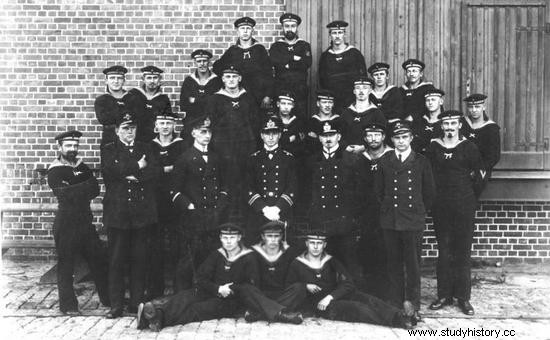
The U-9 crew in full splendor. It was these sailors and officers who turned out to be the vanquishers of the Royal Navy (source:Bundesarchiv; lic. CC BY-SA 3.0)
A fired squadron
Suddenly, a fountain of water arose on the port side of the flagship HMS Aboukir, sailing at the head of the squadron, and a pillar of smoke rose. The ship rocked sharply. Its bow part broke and at the same time he strongly leaned to the port side . The commander of the cruiser and the entire team, Cdr Drummond, ordered a signal posted: I stepped on a mine. I need help…! However, the fate of the ship was doomed. The Hogue approached the flagship unit with the intention of evacuating the crew. The Cressy also stopped and lowered the lifeboats.
At the same time, the U-9 was making a turn. Capt. Weddigen watched the rescue operation. This time the "Cressy" were targeted, but the HMS Hogue was attacked because of those lifeboats that could cut the torpedo course. The ship already carried a large part of the crew from the sinking Aboukira. At about 6.55 two torpedoes struck her starboard. The cruiser quickly banked to starboard. This time there was no doubt anymore:the cruisers had been attacked by several submarines - or so the British believed.
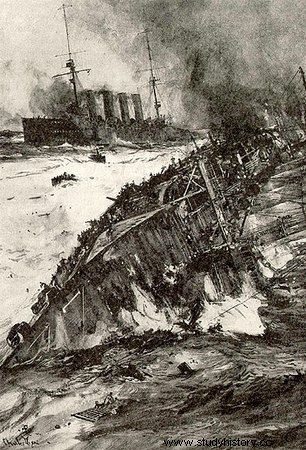
When HMS Hogue set out to rescue the crew of the sinking HMS Aboukir, it was also hit by German torpedoes.
Commander Robert W. Johnson, commander of the last undamaged ship, HMS "Cressy", sent a dramatic cable to the Admiralty stating the position and losses of the squadron. It caused a real panic in the headquarters of the British fleet when it became known that the cruisers did not have anti-submarine cover . They were immediately sent a destroyer flotilla.
This article has more than one page. Please select another one below to continue reading.Attention! You are not on the first page of the article. If you want to read from the beginning click here.
Fighting windmills
Meanwhile, in the coastal waters of the Netherlands, the final act of the drama of the English cruisers was unfolding. Commander Johnson ordered fire from his ship's main guns. "Cressy" fired blindly, trying to scare the underwater enemy away. So did the sinking Hogue . The commander of the latter, Cdr Nicholson, also ordered the crew to dress warmly and carry all swimmable things on board. However, these were the last moments of the Hogue, which was lying more and more on the port side. At 7:15 AM he finally sank into the waves of the North Sea.
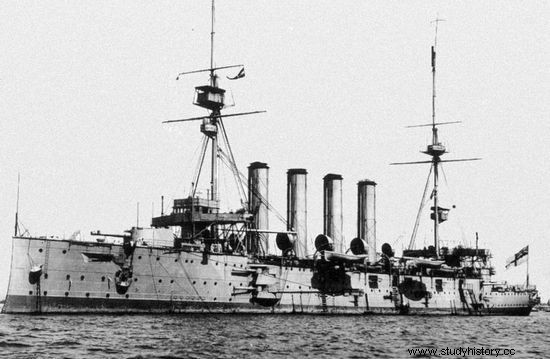
HMS Cressy, Commander Nicholson, despite desperate attempts to sink the U-boat, shared the fate of the remaining ships of the British squadron.
The shelling of the cruisers obviously did not cause any damage to the U-9, although during a subsequent interrogation one of the "Cressy" artillerymen swore to see one of the submarines was hit by a third or fourth shell ! Captain Weddigen was getting ready to deliver the killing blow to the last surviving unit of the ill-fated squadron . Unfortunately for the English seafarers, it was just a completion of the formalities.
Commander Johnson, who might have left the endangered area, decided to stay and undertake a rescue operation. Five minutes after the Hogue sank, HMS Cressy was hit by two torpedoes. One of them hit the ship's boiler room, causing a powerful secondary explosion. Since the cruiser no longer had any lifeboats, the crew began to throw anything that could swim overboard. Thanks to Cdr Johnson's efforts, panic was averted and the evacuation was extremely peaceful.
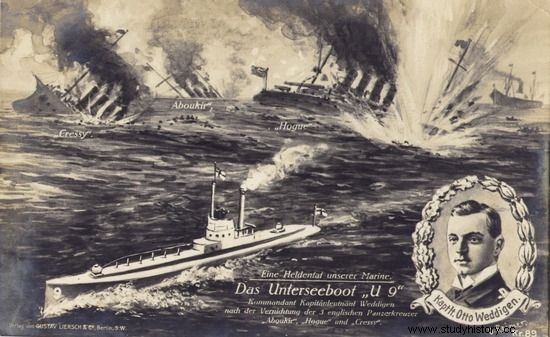
A German postcard to commemorate the spectacular success of Otto Weddigeng and his crew.
The cruiser did not sink as fast as the Germans wanted it to sink. Weddigen ordered the hapless ship to finish and the U-9 fired his deadly cigar again . At. At 7:35 Cressy capsized and sank. A total of 1,443 people died from all three ships, including the brave Commander Johnson.
End of the myth of an invincible fleet
The tragedy of Cmdr Drummond's squadron was a real shock to the British, who believed that their fleet was second to none. It exposed all the shortcomings of the Royal Navy, whose commanders were completely unprepared to deal with the new kind of threat that the German U-boats had become. This resulted in professional consequences for several senior naval officers, including Cdr Drummond.
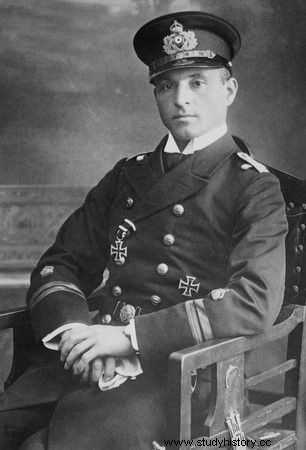
The success of Capt. Otto Weddigen made him a national hero of Germany. The photo shows the Iron Cross, class I, which he received for the operation of September 22nd.
The aftermath of Weddigen's victory was also, in a sense, the resignation of the First Lord of the Admiralty, Admiral Ludwik Battenberg, a German of German origin, forced by the anti-German moods of a large part of British society. In addition, there has been a veritable "U-boat psychosis" among British seafarers . Even the main forces of the fleet were withdrawn to more distant bases to protect them from attacks by German submarines.
The first "ace" of the Imperial Navy
Captain Weddigen returned to Germany in glory. Emperor William II himself awarded both him and the ship's flag with the Iron Cross of the 1st class. The Austro-Hungarian Emperor Franz Joseph did a similar thing. Three weeks later, on October 15, 1914, Weddigen sank another British cruiser HMS Hawke near Aberdeen. For his fourth success, Otto Weddigen was awarded as the first U-boat commander the highest German Pour Le Merite award . The happiness of the war left the first ace of the German submarine on March 18, 1915, when the new U-29 ship under his command was rammed and sunk by the battleship HMS Dreadnought. All the crew died, including the commander.
Editor:Krzysztof Chaba; Photo edition:Rafał Kuzak
